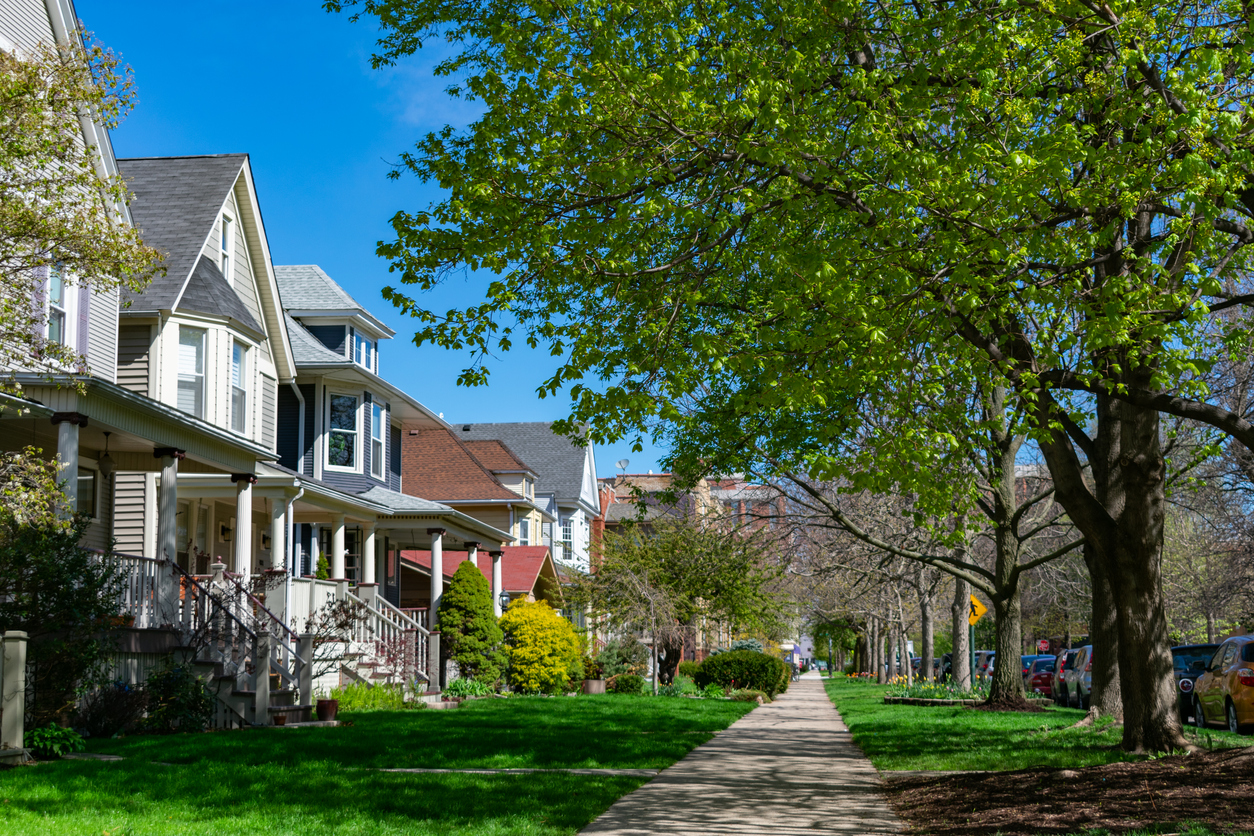As the CEO of a Chicago-based real estate company, you're likely keeping a close eye on the latest housing market trends in the Windy City.
With home prices rising steadily over the past couple of years though at a more moderate pace recently, and inventory remaining tight across most neighborhoods, there's a lot of uncertainty about what's in store for 2024.
John Goodrich of Chicago-based I Buy IL says the market feels like it teeters daily, not knowing whether things will pick back up sharply or trends could worsen. But he sees reasons for cautious optimism. This guide breaks down the need-to-know dynamics around inventory, mortgage rates, buyer and seller behaviour, economic factors, market segment performance, neighbourhoods, and environmental considerations. Read on for insights into navigating the ever-shifting tides of Chicagoland real estate.
Housing Inventory & Sales Volumes
As a real estate exec, one of your top concerns is likely the lack of homes available for buyers. John Goodrich says inventory has plagued the industry for years now, and while more new construction came online last year, resale homes remain in short supply. The situation may be slowly starting to improve but still a long way to go.
Sales volumes are down year-over-year, though experts believe they likely bottomed out in 2023. With low mortgage rates incentivizing current homeowners to stay put, new listings aren't entering the market quickly enough to satisfy demand. Homes that do get listed often sell very rapidly — typically under 25 days in Chicago. Fierce bidding wars still erupt in some areas or for the most move-in-ready properties.
So while tighter inventory keeps putting upward pressure on prices, home values are no longer accelerating as quickly as during the peak pandemic years. As you progress through 2024, more supply could help take intensity out of the market and make things a tad less competitive for buyers.
Mortgage Rates & Affordability
Sharply climbing mortgage rates over the past year have been a primary culprit behind slowing home sales and the reluctance of many current owners to sell, trade up, or relocate. But the good news is rates have moderated substantially from their 2022 highs. John Goodrich of I Buy IL says as rates inch downward in 2023, he expects improved housing affordability will draw more prospective purchasers back into the hunt.
With rents also spiking dramatically across Chicagoland lately, buying a home still makes financial sense in many areas from a monthly payment perspective. And with median sale prices now increasing above the overall inflation rate, real estate remains an attractive asset class over the long run to grow wealth. If the Federal Reserve cuts interest rates later this year as projected, that could provide a welcomed affordability boost just when buyers need it most going into the critical spring season.
Buyer & Seller Psychology
In addition to stubbornly low inventory, warp-speed price gains, and fluctuating mortgage rates, buyer and seller mindsets have contributed to the market's volatility lately. John Goodrich of I Buy IL believes psychology is hugely impactful in real estate. When current owners feel unsure about trading their low-rate loan for a much higher one, they're apt to simply stay put and remodel or expand their existing home if possible. Builders have benefited from this dynamic, as new construction purchases sidestep the rate gap dilemma.
Additionally, with rents rising so substantially in recent years, more young renters who can afford it are determined to finally break into homeownership rather than keep lining their landlord's pockets. So bidding wars still erupt in opening weekends for the most competitively-priced, move-in-ready listings in core city neighbourhoods. Investors also remain active, especially for solid rental properties. So don't expect the spring and summer markets to lose their intensity just yet, even if the pace continues moderating.
Economic Outlook & Policy
As a real estate exec, you're probably keeping tabs on what economists and industry veterans anticipate for the housing market and economy overall in the coming year. The consensus seems to be increased optimism compared to the gloomier forecasts from mid-2022. Inflation is expected to keep gradually easing, allowing the Fed to cut interest rates in 2024 for the first time in years. Job and wage growth also remain strong in Chicago, offering stability.
However, Goodrich of I Buy IL says some concerns linger around how city policy could impact housing dynamics. Proposals for substantially higher transfer taxes on high-end property sales are likely to move forward, acting as deterrents for purchasing or investing within city limits. If luxury buyers shift focus to the suburbs, that could influence migration patterns. While unemployment remains low, analysts will be monitoring how remote work evolves and whether more residents depart for affordable secondary markets. On the whole, though, market experts don't foresee conditions worsening in Chicagoland real estate if the economy stays the course.
Segment Performance Variations
Drilling down into specific market segments reveals noteworthy performance divergences. For example, John Goodrich says demand for downtown Chicago condos has lagged the broader market's pandemic rebound. With some corporate offices not yet back to full capacity, sales and pricing growth for urban high-rises hasn't matched that of detached houses or suburban townhome communities. Geographical differences across the metro area are also key to understanding.
Alternatively, the new construction niche has thrived throughout recent years as buyers eager to capitalize on low rates and generous builder incentives opted for modern, more energy-efficient homes rather than older housing stock. Rural and vacation regions outside Cook County have additionally drawn strong interest from city dwellers able to work remotely. And despite economic uncertainty and stock market volatility, the high-end luxury market continues to hum along thanks to financially resilient ultra-high-net-worth buyers less deterred by rising rates or home prices. So performance varies significantly depending on property type and area.
Geographic Differences
On the topic of geographical differentiation, as the leader of a real estate firm, you're surely aware that Chicagoland neighbourhoods and suburbs each possess their own unique character, demographics, amenities, housing options and market tendencies. Broadly speaking, John Goodrich says urban cores faced faster price ascents over the past decade which causes affordability constraints for some middle-class buyers now. Inventory in well-regarded school districts continually runs tight as families compete for limited properties.
But when weighing suburbs against the city proper, don't assume one area vastly outperforms the other. Younger generations still crave walkable mixed-use neighbourhoods. Areas considered boring or inaccessible a decade ago get updated reputations following revitalization efforts. So rather than making sweeping declarations about where to buy, dive into granular neighbourhood analysis about growth drivers, transport access, commercial development plans, and demographic shifts underway.
Forward-looking real estate CEOs focus less on previous stereotypes and more on emerging opportunities. Savvy investors target specific streets showing early hints of ascendance rather than already coveted enclaves far outside their budget range. Remember, today's hidden gem could become tomorrow's hottest neighborhood given enough time and community enhancement efforts.
Environmental Considerations
In addition to market uncertainties, economic conditions, and neighbourhood differentiators, environmental factors represent an emerging consideration for Chicago area home buyers, sellers and real estate leaders. As CEO, climate change, extreme weather event risks, and a greater societal focus on sustainability should be on your radar.
Goodrich of I Buy IL says until recently, spatial data around flooding susceptibility, fire risk zones, hurricane likelihood and heat exposure remained scattered. But consolidated online mapping tools now clearly showcase various hazards posed to listings based on underlying geographical traits. As climate shifts continue, certain vulnerable regions or housing types could face shrinking demand if owners fear rising insurance costs, storm damage or resale difficulties down the road.
And even for inland areas like Chicagoland less prone to hurricanes or wildfires, flooding poses a moderate threat with estimates showing nearly half of the city's properties at risk of severe inundation over the next thirty years. For newer constructions, highlighting advanced weather-resilient building materials, solar roofing, EV charging access and other upgrades may soon become big selling points to the most climate-conscious buyers.
Final Market Predictions
Taking into account the totality of signals — from housing inventory challenges and mortgage shifts to buyer-seller psychologies, economic outlooks, urban-suburban dynamics and climate exposures — industry analysts offer moderately hopeful projections for Chicago's 2024 real estate landscape compared to last year's turbulence.
Goodrich of I Buy IL says the spring and summer markets should still see robust activity as long as unemployment stays low and the stock market avoids major slides that could diminish consumer confidence sharply. Others caution upcoming elections could stir economic uncertainty that temporarily cools sales, and further Fed actions might impact rates unpredictably.
So amidst unpredictable elements outside one's control, real estate execs must remain nimble and keep focussing on company growth opportunities when able. Leverage emerging technologies to streamline operations, strengthen agent training programs to stand out from competitors, and lean into underserved geographical niches or demographic segments.
And if 2024 proves rockier than expected, capitalize on periods of market correction when able to expand office footprints or investment portfolios at reasonable valuations. Stay alert to shifts underway across Chicagoland, and concentrate on community relationships. Keep adapting your service offerings to match what buyers and sellers seek to make quick real estate transactions as needs evolve across market cycles.
Key Takeaways
Fast-moving Chicago real estate market trends, and tight inventories will likely continue plaguing buyers in years ahead, but relief could start materializing as 2023's plunging mortgage rates attract more would-be sellers. Rates declining from recent highs improves overall affordability, though various segments and neighbourhoods follow unique trajectories based on amenities, housing stock, development initiatives and underlying consumer demand drivers.
While the market's direction still hinges considerably on Fed actions and the economy at large, analysts don't foresee a drastic downturn locally barring an unforeseen shock. Election year uncertainty could momentarily moderate activity, but 2024 is broadly expected to see a measured rebound in transaction volumes versus the marked cooldown of 2023. But by providing adaptable solutions to meet buyers' and sellers needs across market environments, resilient leaders can propel their organizations to success this year and over the longer-term horizon.











